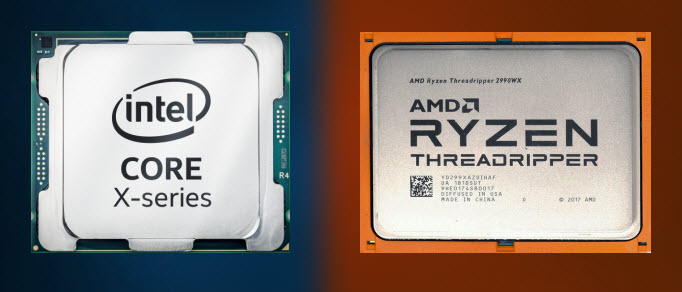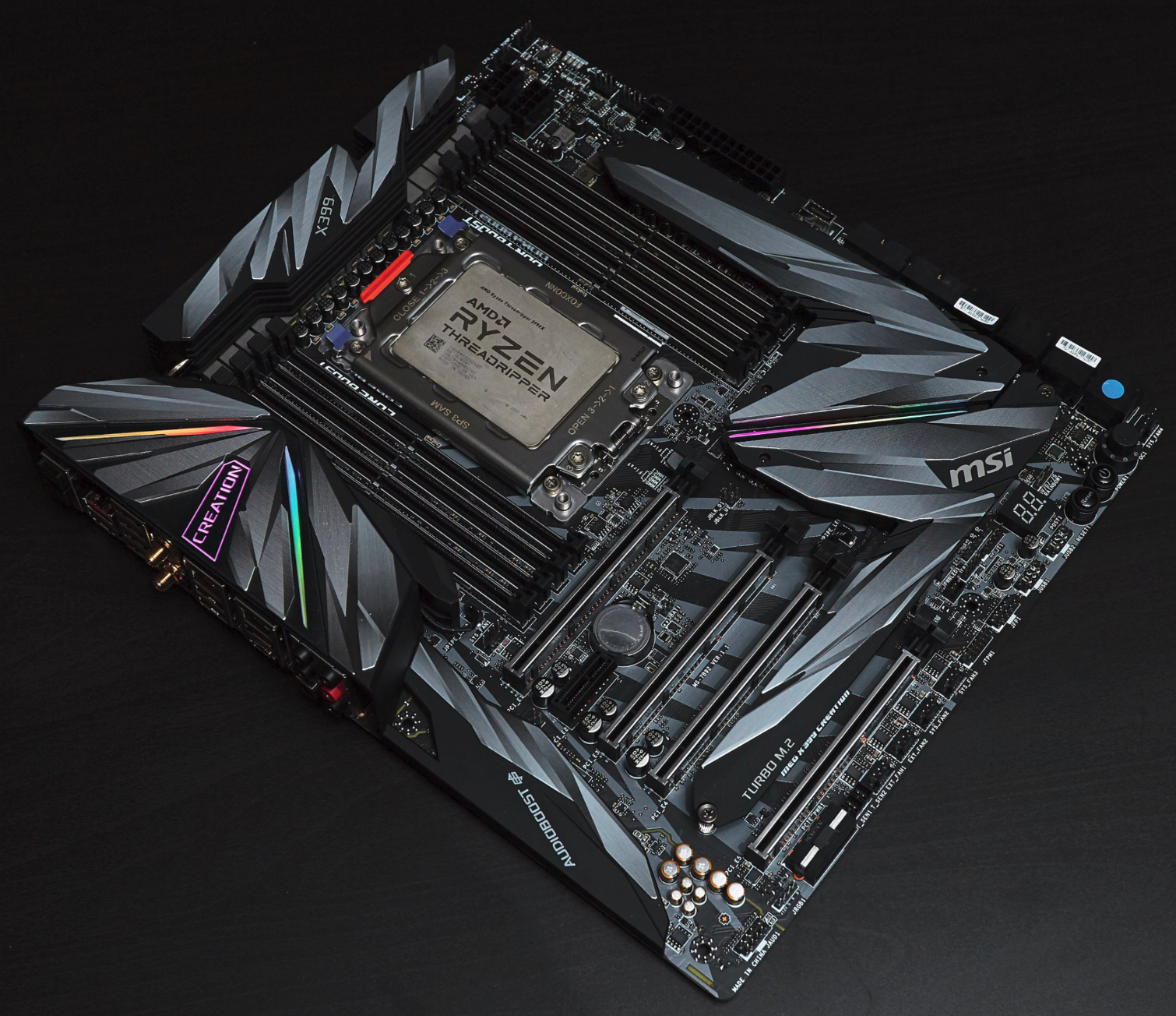AMD Ryzen Threadripper 2 vs. Intel Skylake-X: Battle of the High-End CPUs
It's one of the greatest questions of our time: AMD or Intel? Today, that rivalry has entered a new stage of Cinebench taunting as AMD's 2000-series Threadripper processors, commonly known as Threadripper 2, come to market to compete against Intel's Skylake-X series.
The high end desktop (HEDT) segment is the land of stupid-high prices, with the $1,999 Core i9-7980XE capping the top of Intel's line and the $1,799 Ryzen Threadripper 2 2990WX serving as AMD's halo product. These chips straddle the line between professional workstation-class products, like Intel's Xeon W line, and the upper end of the desktop PC stack. For prosumers and creators, like the streamers and video producers of the world, this class of processor is worth the premium.
There's never been a better time to buy a high-end processor. To help you decide which processor platform to get, we've put Ryzen Threadripper 2 and Skylake-X through a seven-round face-off.
Features
AMD holds the core-count advantage with its range-topping 32C/64T Threadripper 2990WX. Core counts vary based on pricing. Intel's lineup spans from six cores to eighteen, while AMD's spans from eight cores to 32.
| Row 0 - Cell 0 | Row 0 - Cell 1 | Cores /Threads | Base / Boost (GHz) | L3 Cache (MB) | PCIe 3.0 | DRAM | TDP | MSRP | Price Per Core |
| AMD | TR 2990WX | 32 / 64 | 3.0 / 4.2 | 64 | 64 (4 to PCH) | Quad DDR4-2933 | 250W | $1,799 | $56 |
| AMD | TR 2970WX | 24 / 48 | 3.0 / 3.2 | 64 | 64 (4 to PCH) | Quad DDR4-2933 | 250W | $1,299 | $54 |
| Intel | Core i9-7980XE | 18 / 36 | 2.6 / 4.4 | 24.75 | 44 | Quad DDR4-2666 | 140W | $1,999 | $111 |
| AMD | TR 2950X | 16 / 32 | 3.5 / 4.4 | 32 | 64 (4 to PCH) | Quad DDR4-2933 | 180W | $899 | $56 |
| AMD | TR 1950X | 16 / 32 | 3.4 / 4.4 | 64 | 64 (4 to PCH) | Quad DDR4-2667 | 180W | $750 | $47 |
| Intel | Core i9-7960X | 16 / 32 | 2.8 / 4.4 | 22 | 44 | Quad DDR4-2666 | 140W | $1,699 | $106 |
| Intel | Core i9-7940X | 14 / 28 | 3.1 / 4.3 | 19.25 | 44 | Quad DDR4-2666 | 165W | $1,199 | $86 |
| AMD | TR 2920X | 12 / 24 | 3.5 / 4.3 | 32 | 64 (4 to PCH) | Quad DDR4-2933 | 180W | $649 | $54 |
| AMD | TR 1920X | 12 / 24 | 3.5 / 4.2 | 64 | 64 (4 to PCH) | Quad DDR4-2667 | 180W | $399 | $33 |
| Intel | Core i9-7920X | 12 / 24 | 2.9 / 4.4 | 16.50 | 44 | Quad DDR4-2666 | 140W | $1,199 | $100 |
| Intel | Core i9-7900X | 10 / 20 | 3.3 / 4.3 | 13.75 | 44 | Quad DDR4-2666 | 140W | $999 | $99 |
| Intel | Core i7-7820X | 8 / 16 | 3.6 / 4.3 | 11 | 28 | Quad DDR4-2666 | 140W | $599 | $75 |
| AMD | TR 1900X | 8 / 16 | 3.8 / 4.2 | 20 | 64 (4 to PCH) | Quad DDR4-2677 | 180W | $340 | $42.5 |
| Intel | Core i7-7800X | 6 / 12 | 3.5 / 4.0 | 8.25 | 28 | Quad DDR4-2400 | 140W | $389 | $65 |
| Intel | Core i7-7740X (EOL) | 4 / 8 | 4.3 / 4.5 | 8 | 16 | Dual DDR4-2666 | 112W | $350 | $87.5 |
| Intel | Core i5-7640X (EOL) | 4 / 4 | 4.0 / 4.2 | 6 | 16 | Dual DDR4-2666 | 112W | $243 | $61 |
All Threadripper 2 and Skylake-X models come equipped with multithreading, meaning software can assign two threads to each core. Intel calls this Hyper-Threading, and AMD uses the more generic Simultaneous multithreading, or SMT.. Intel and AMD have similar peak clock speeds at each step on the ladder, but not all cores are created equal. Intel holds the per-core performance advantage and generally processes more instructions per cycle (IPC). Intel's per-core performance advantage equates to more performance and responsiveness in lightly-threaded applications, such as most games and general desktop PC applications.
AMD's Ryzen Threadripper 2 offers improved performance in heavily-threaded productivity applications, like rendering, video editing, and transcoding, and it also boosts performance in game titles that can utilize the extra cores and threads. Threadripper 2 also comes with Precision Boost 2, which is similar to Intel's multi-core boost implementation that provides higher boost frequencies when applications exercise multiple cores at once. Neither company discloses the full list of turbo frequencies, so it's hard to make comparisons based on the specifications alone, but we'll see how the different approaches impact performance below.
AMD also supports ECC memory, which is a critical component for professionals and semi-professionals who value every bit of their data. ECC detects and corrects errors automatically to help ensure data integrity, and AMD's ECC support blurs the line between workstation-class processors and their high end desktop equivalents.
Get Tom's Hardware's best news and in-depth reviews, straight to your inbox.
Winner: AMD. The Threadripper 2 lineup comes with 60 PCIe lanes exposed to the user regardless of price, while Intel reaches a hard limit of 44 but charges you extra for each step up the ladder. AMD also supports ECC memory, which is an important advantage for professional and semi-professional workloads.
Overclocking
Both Intel and AMD offer unlocked ratio multipliers with their high-end desktop processors, meaning that you can overclock at will. AMD's X399 and Intel's X299 platforms, which power the motherboards for these chips, also both support overclocking.
You'll pay for the privilege, but Intel typically reaches higher clock rates through overclocking. Of course, the silicon lottery applies, so chip quality can have an impact on the maximum attainable overclocks, and you'll have a harder time providing enough cooling for the Intel processors, as we'll cover below. Intel still holds the overall lead in achievable overclocking frequencies at any given price point, but AMD is competitive.
AMD also has its Precision Boost Overdrive (PBO) technology baked right into its high end models. The new feature automatically overclocks your processor based on the amount of thermal headroom and power delivery available. That equates to a hassle-free performance boost that handles all of the dirty work for you. Intel does not have a comparable feature.
Intel holds the advantage on the memory overclocking front. The company's processors have a much higher memory data transfer rate potential than AMD's lineup. AMD's Zen microarchitecture profits greatly from increased memory data transfer rates, which often manifests as impressive performance scaling in games, while you don't see as much of a progressive performance increase from the Intel models.
Finally, overclocking is a dangerous pursuit. You can easily kill your coveted processor with too much voltage, which is a pricey mistake with this class of processor. For an extra fee, Intel offers an extended warranty plan that covers damage due to overclocking. AMD doesn't offer an extended plan.
Winner: Tie. Intel holds the overall performance advantage after you tune your processor, but you'll have to work harder to get there. Intel's extended warranty plan does take some of the risk out of the process, though. AMD's processors are easier to cool and generally require much less effort to boost the clock rates, and the automated PBO overclocking feature is a godsend for beginners.
Coolers
High end processors come without bundled coolers, but the chips' inherent characteristics define how much you'll have to pay for a cooling solution.
The thermal interface material between the heat spreader and the die is an important consideration. These materials are designed to speed heat transfer, thus improving dissipation. Ultimately, better heat dissipation reduces cooling requirements during normal operation and also allows for higher overclocks.
AMD uses Indium solder between the CPUs' heatspreader and die, while Intel uses standard thermal paste. AMD's Indium solder is much more effective than Intel's thermal paste, which makes it easier, and less expensive, to cool your processor. AMD recommends a beefy air cooler as the minimum cooling requirement for Threadripper 2, but Intel defines water cooling as the basic requirement for Skylake-X. It should go without saying, but watercooling is more expensive.
The processors' thermal design power (TDP) rating serves as a general indicator of power consumption and thermal generation. AMD's X-series Threadripper 2 chips weigh in with a 180W TDP, while Intel models with comparable core counts have a 140W rating. We've found that AMD's processors generally draw less power under heavy load (at stock settings), while Intel has lower idle power consumption. The WX-series Threadripper 2 models fall into their own unique category. These processors come with industry-leading core counts that equate to a record-high 250W TDP rating.
Winner: AMD. Both companies use different test methodologies to define their TDP ratings, making direct comparisons tricky. We've found that AMD's processors are far easier to cool, largely due to the high-quality solder.
Motherboards
AMD and Intel's motherboard ecosystems are also a key consideration. Intel's X299 and AMD's X399 chipsets both support overclocking.
AMD has a great track record of backward compatibility. For instance, the company has promised to support its AM4 motherboards (the models that support mainstream Ryzen processors) until 2020, so you can upgrade your system by simply dropping in a new processor.
AMD hasn't made a similar statement about the X399 chipset that hosts the Threadripper 2 processors, but the company's actions speak louder than words. AMD's second-gen Threadripper processors drop into existing TR4 motherboards, so you won't need to upgrade to a new X399 motherboard if you're moving forward a generation.
That does come with a caveat, though. AMD's new Threadripper 2 WX-series processors pull far more power than their predecessors and AMD only guarantees that older motherboards will support operation at stock frequencies. The power delivery subsystem on older motherboards may not provide enough juice to push the brawny Threadripper 2 CPUs into overclocked territory, and the generally weaker power distribution will also hinder performance with the PBO automated overclocking feature. In other words, you'll need to upgrade your motherboard if you plan on overclocking.
In contrast, Intel refreshes its chipsets and sockets more frequently. The Skylake-X models won't work in the previous-generation motherboards, so 200-series motherboards are your only option. Intel hasn't guaranteed socket support for its future processors, so it’s possible that newer chip generations will require a new motherboard, which restricts upgrade options.
In general, X299 motherboards are far less expensive, though. X399 motherboards start at roughly $300, but you can find a capable X299 motherboard for Intel's chips for around $200.
Winner: Intel. The X299 motherboard ecosystem is more diverse, meaning you have many more options to choose from, and they are also much less expensive than AMD's platform.
Gaming Performance
When it comes to gaming, Skylake-X beats Threadripper 2 on most titles, simply because more games are lightly-threaded and benefit from Intel's higher single-core clock speeds. AMD's processors are generally more competitive in game titles that can leverage their additional cores effectively, such as Ashes of the Singularity: Escalation, but Intel takes the lead in titles that benefit from increased frequency and instructions per clock cycle, like Grand Theft Auto V.




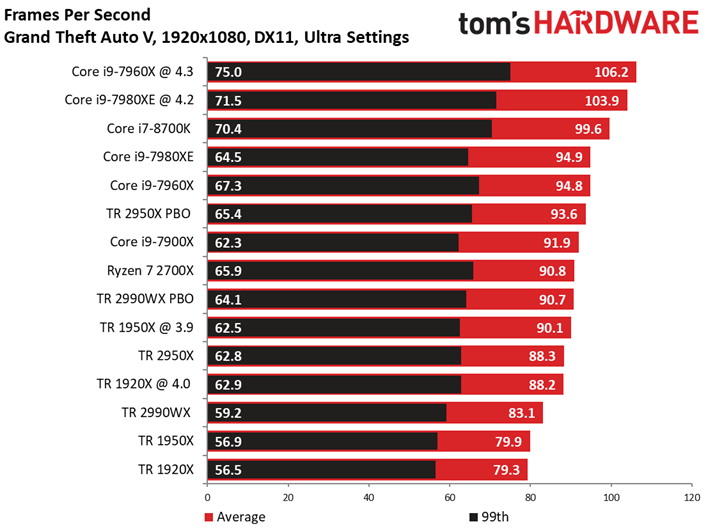
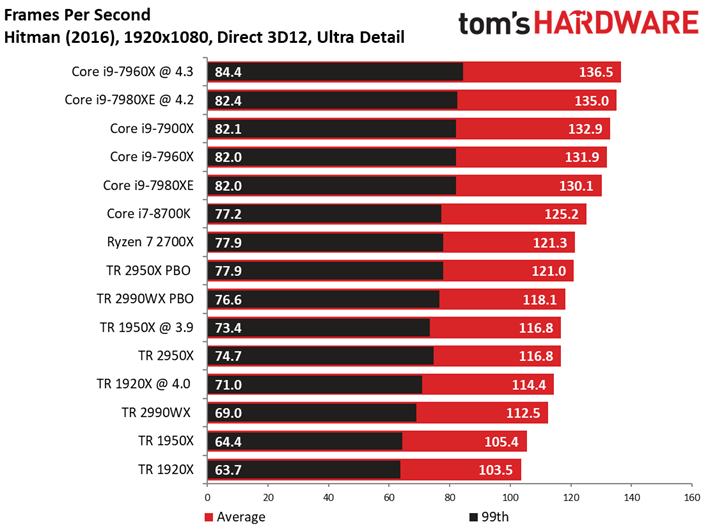
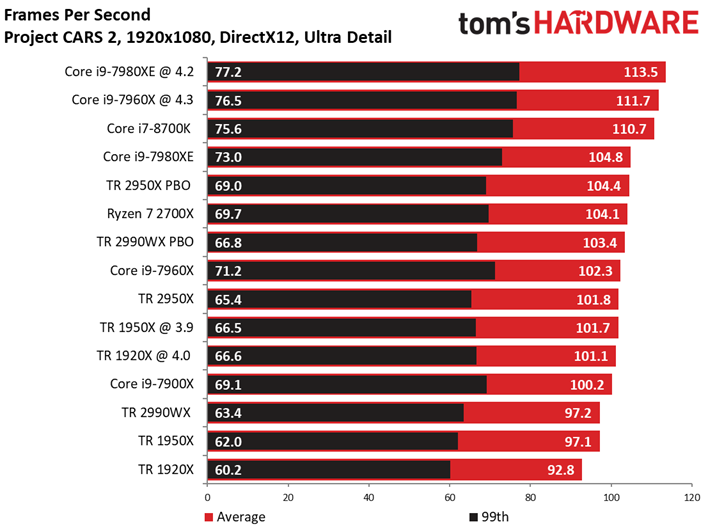
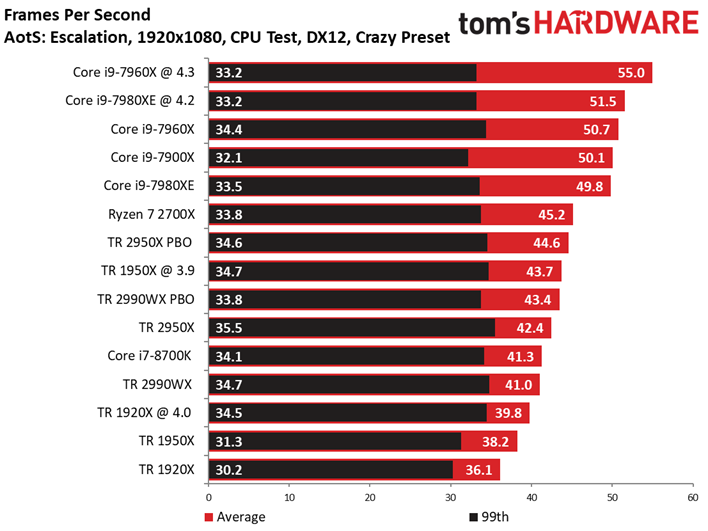
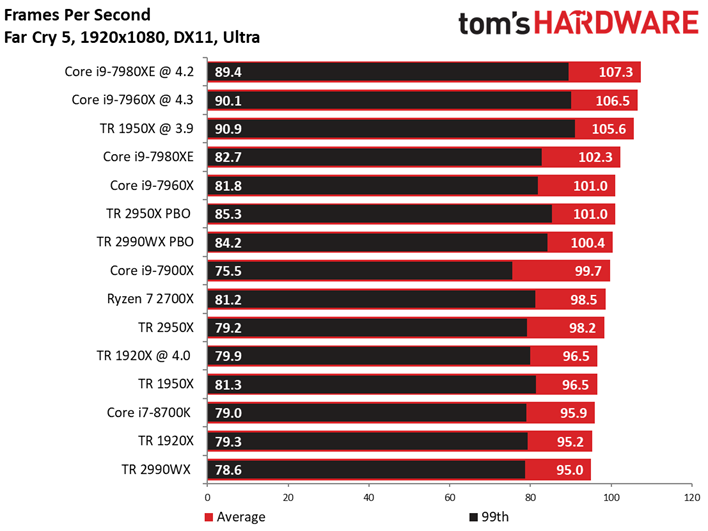
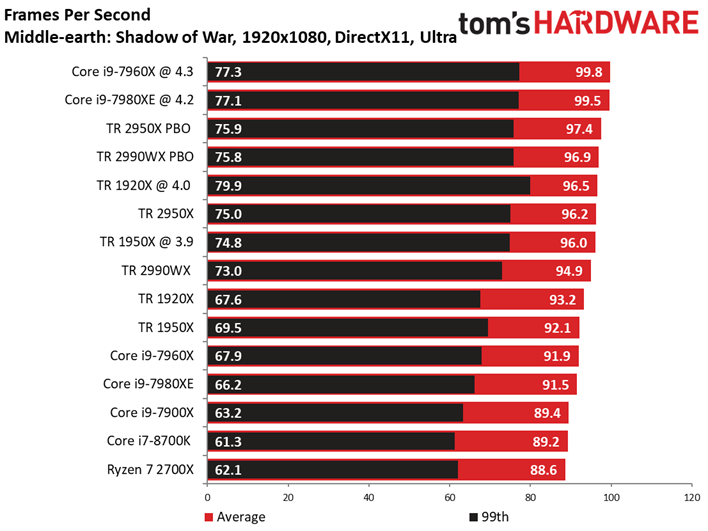

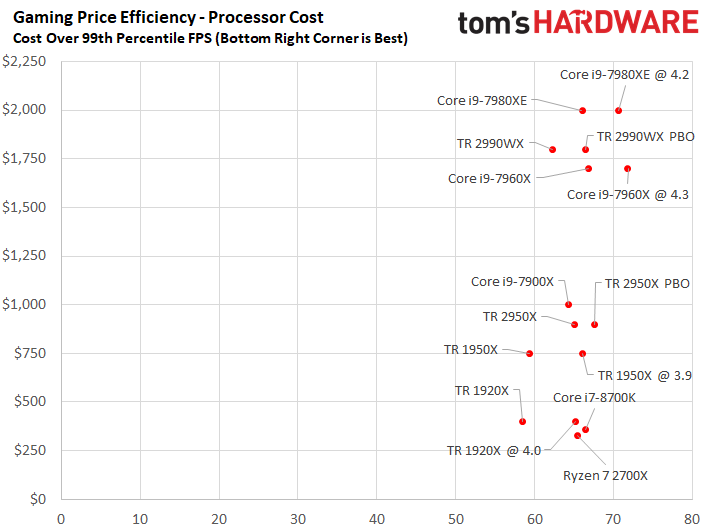
Our first two slides contain a geometric mean of frame rates for all of the games in our standard test suite. We split these values into average frame rates and 99th-percentile frame rates, with the latter being a good indicator of the smoothness of your gaming experience. The remainder of the slides contain the results of each test.
We generally do not recommend HEDT chips for gaming, largely because of the rapidly diminishing point of returns. Mainstream processors, like Ryzen 7 and Core i7, offer similar or better performance at a much lower price point. Intense multi-taskers and streamers will benefit from the increased horsepower of HEDT chips, but you'll have to weigh your workload and budget to decide if the step up is worth it.
Intel's Skylake-X processors offer the highest average gaming performance at both stock and overclocked settings. AMD has made great strides on the gaming front with the X-series Threadripper 2 processors. They don't provide as much peak performance, but they are competitive in our tests at 1080p so you may not notice the difference. If you game with higher resolutions, these performance deltas will shrink further as the GPU becomes the bottleneck.
Winner: Intel offers stronger performance in more games. However, if you're streaming, AMD's multitasking might is better.
Productivity Performance
Our productivity results generally mirror the respective capabilities of Threadripper 2 (2000 series), which tends to perform better in heavily-threaded applications, and Skylake-X processors, which tend to perform best in lightly-threaded apps.
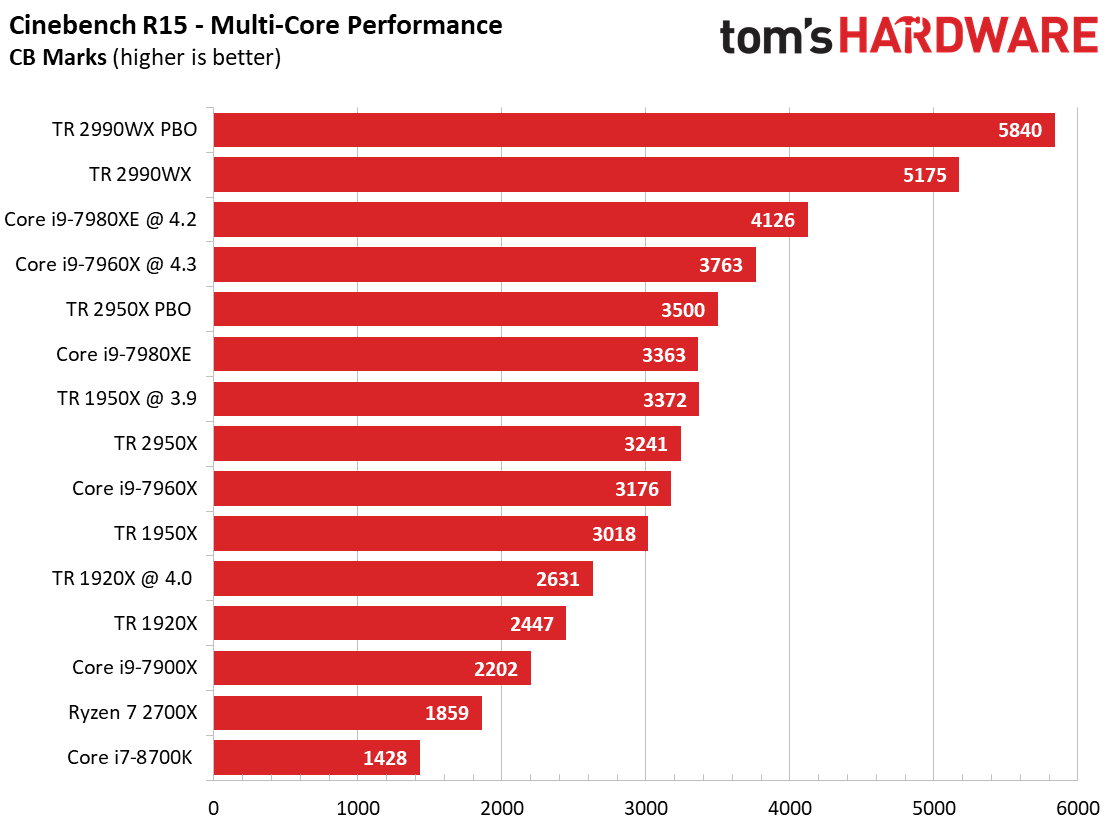

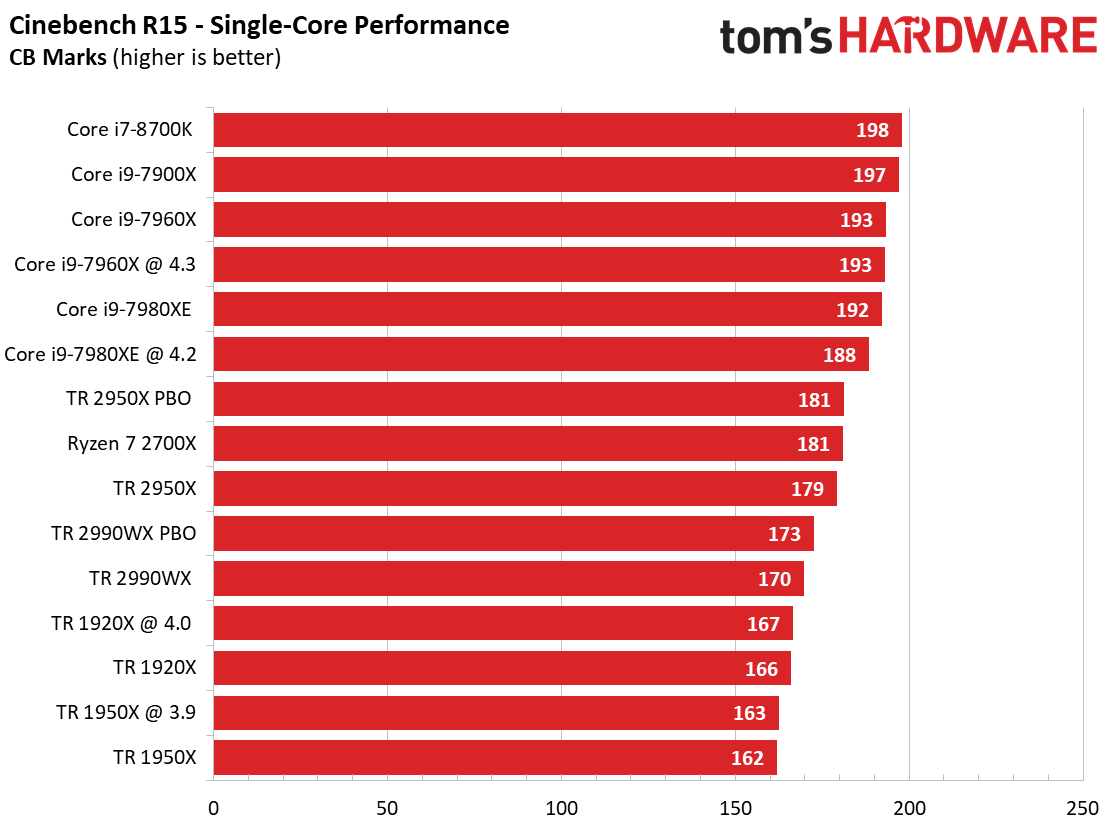
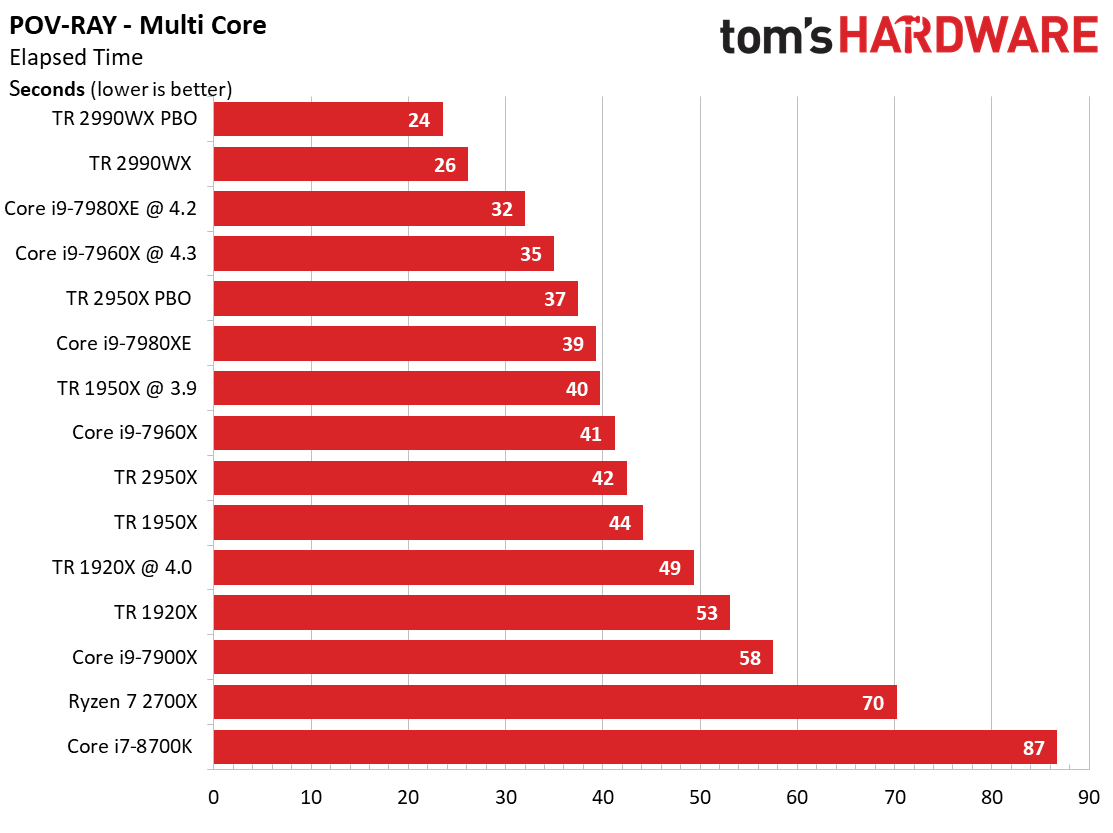
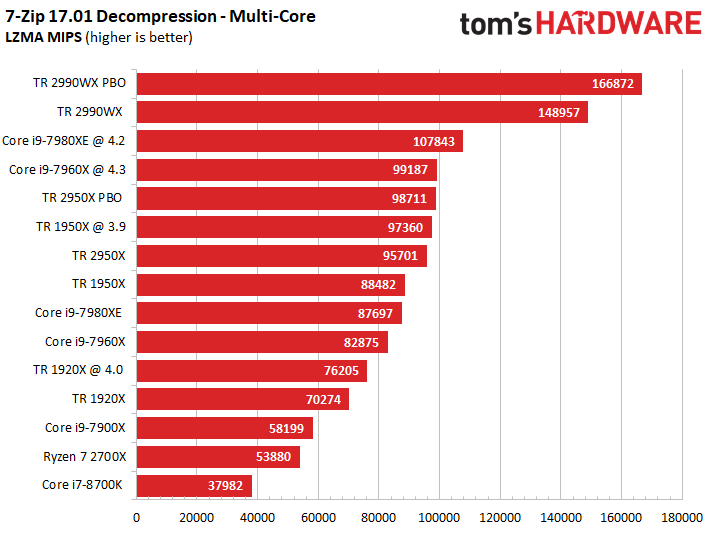
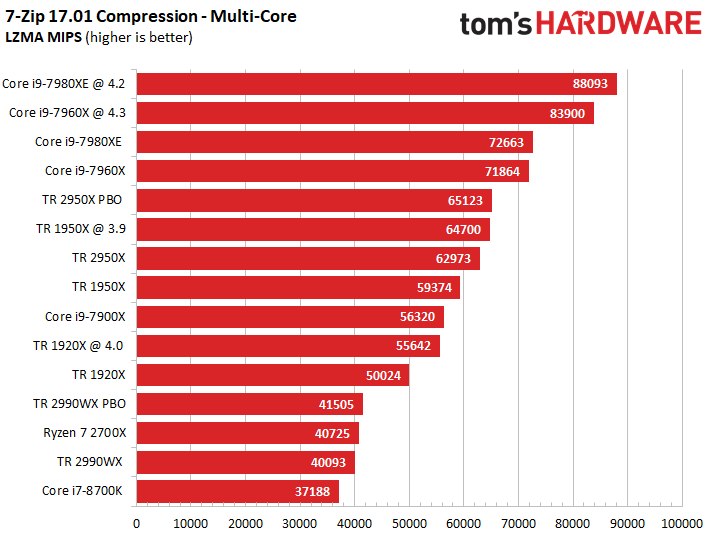
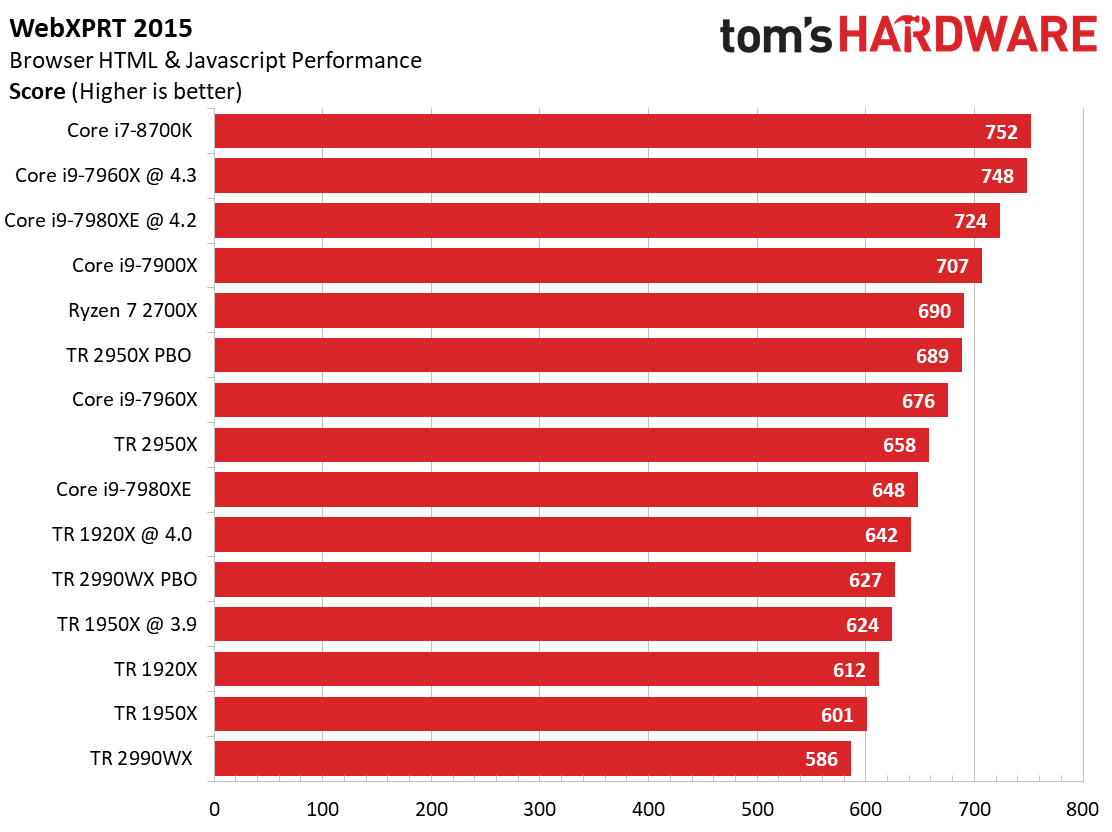
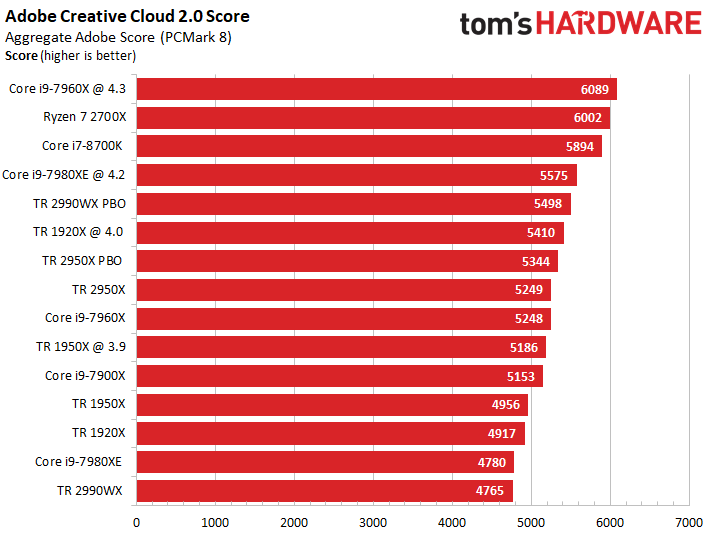
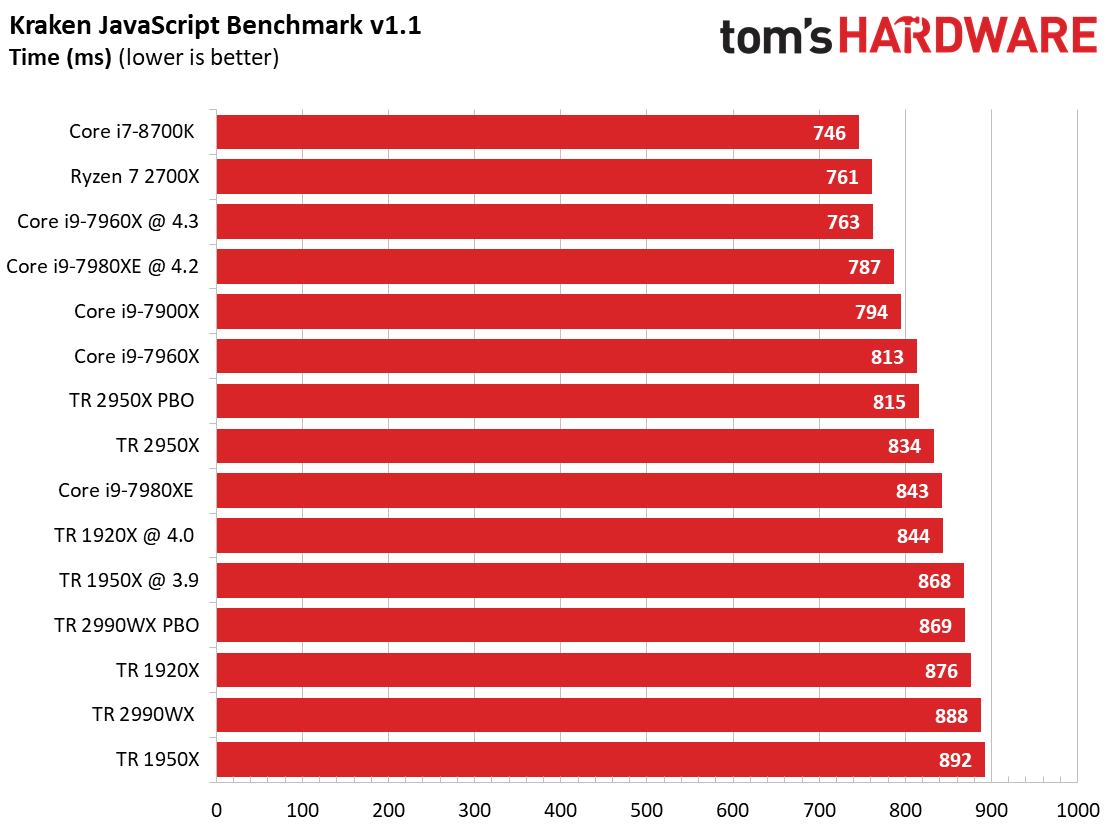

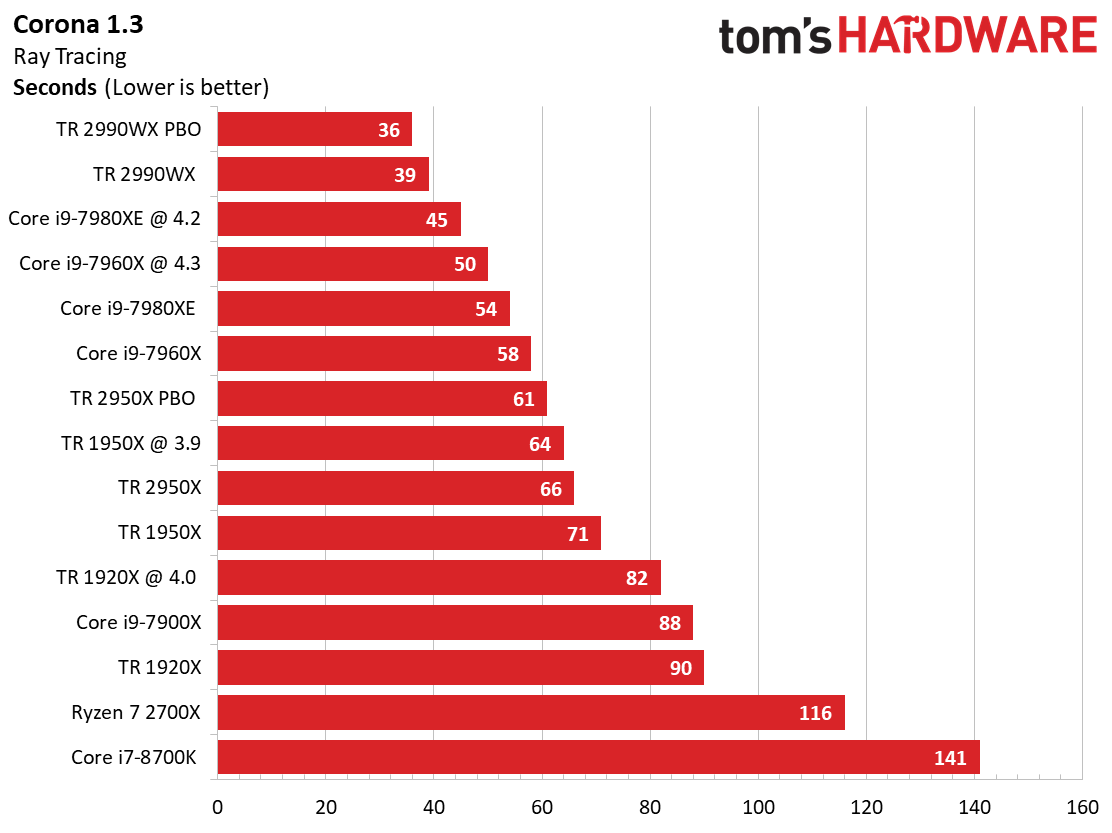
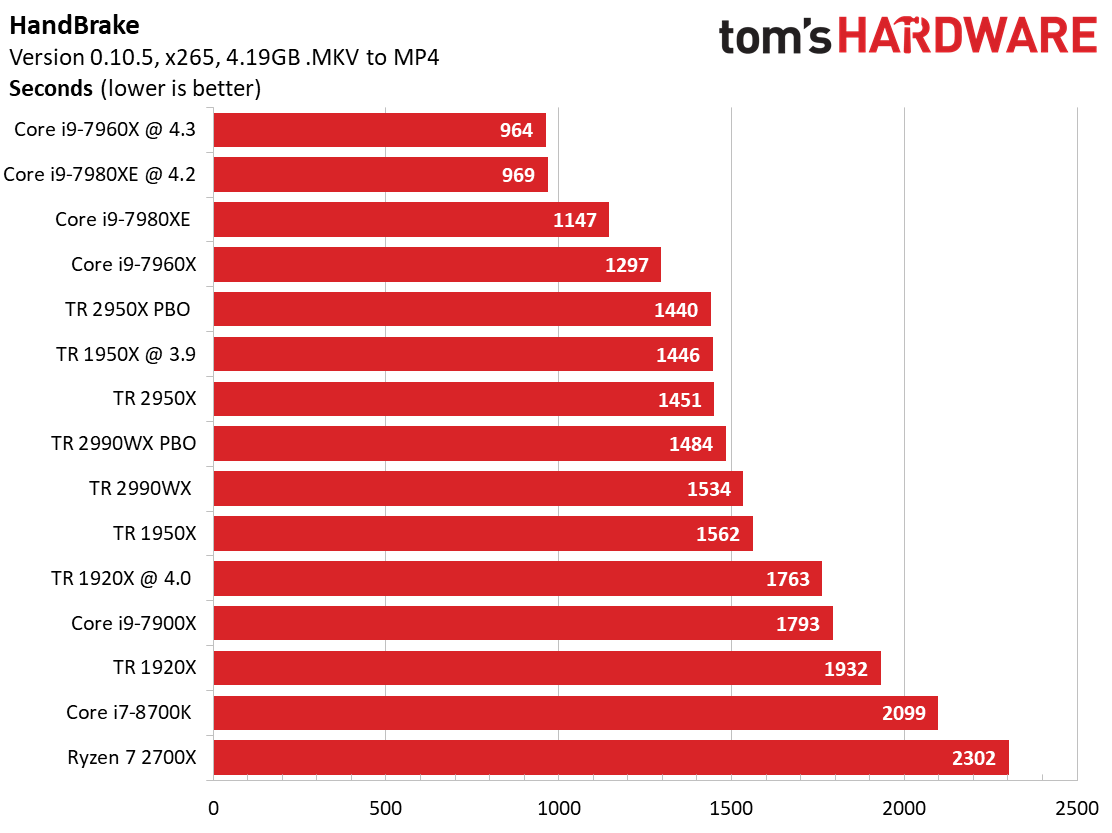
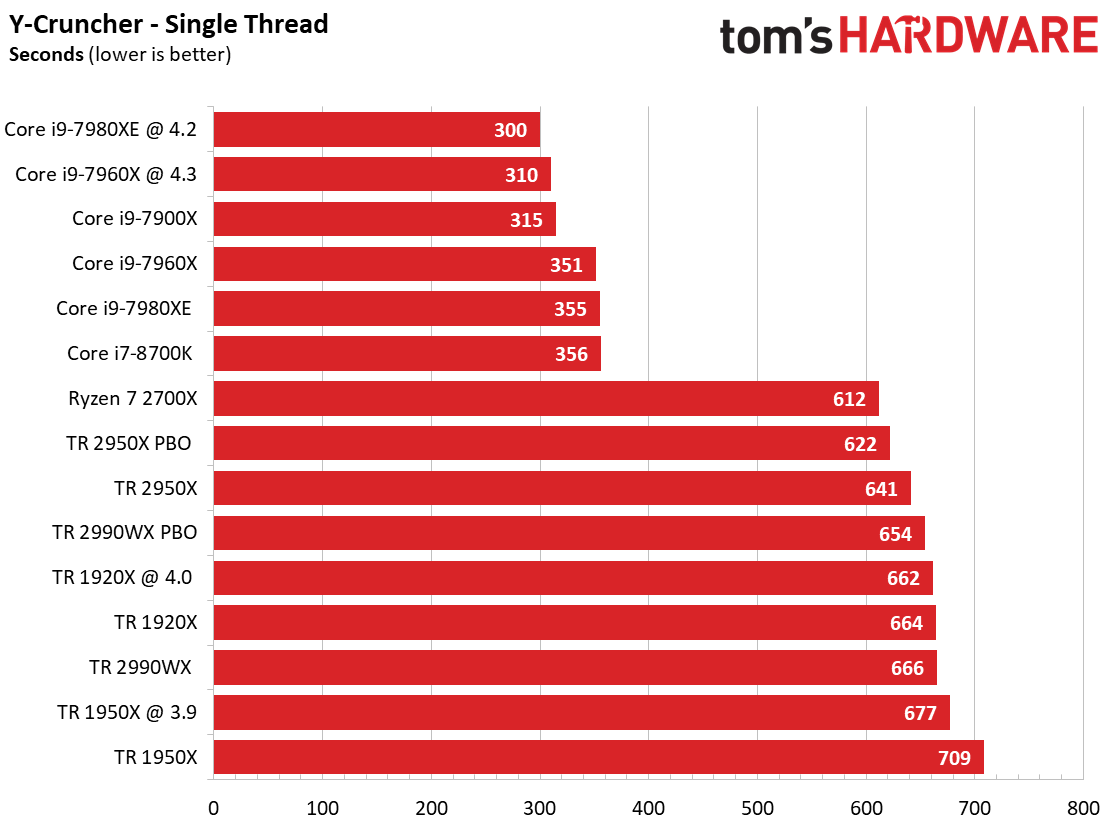
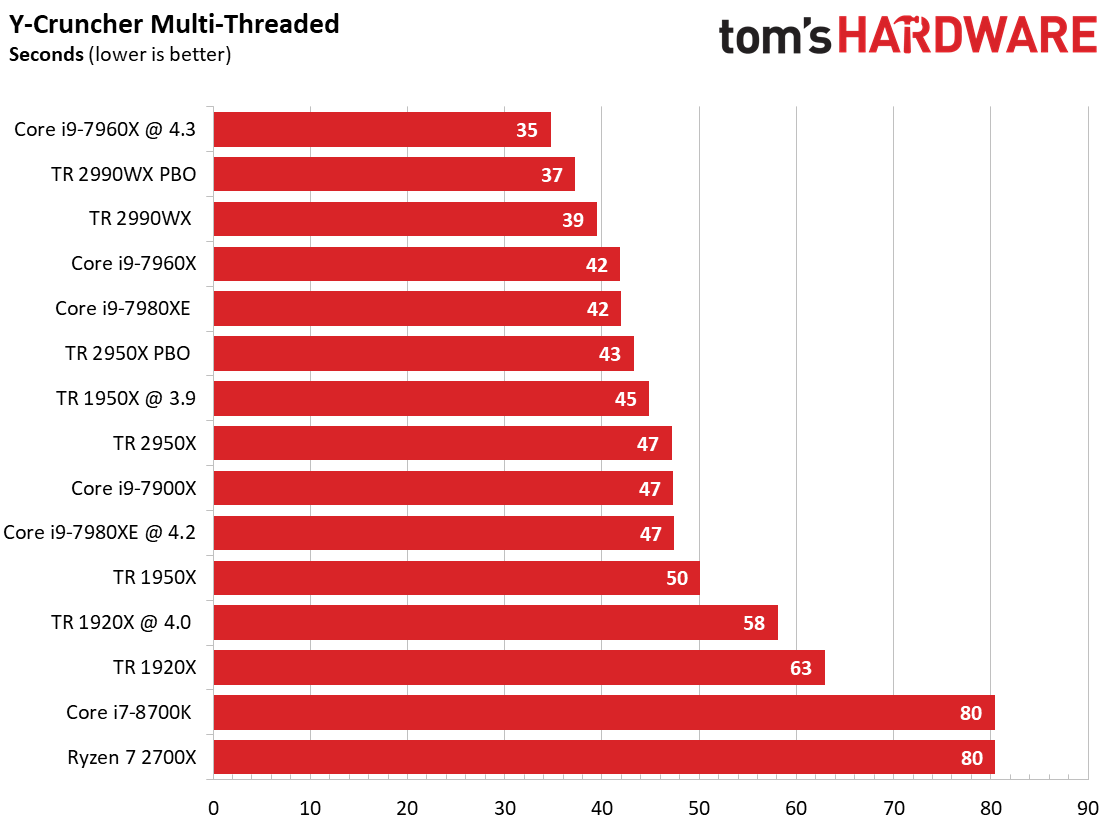

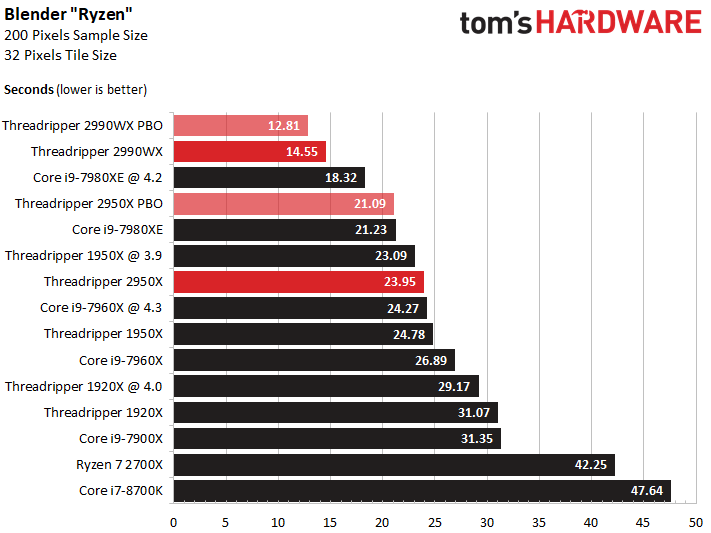
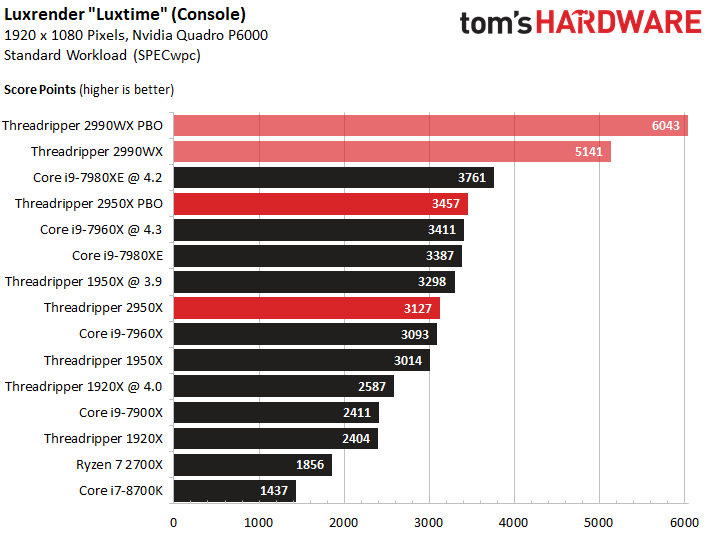

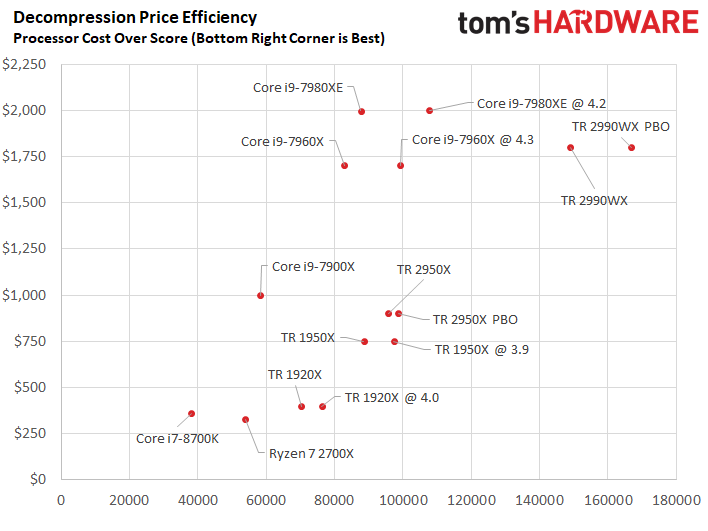
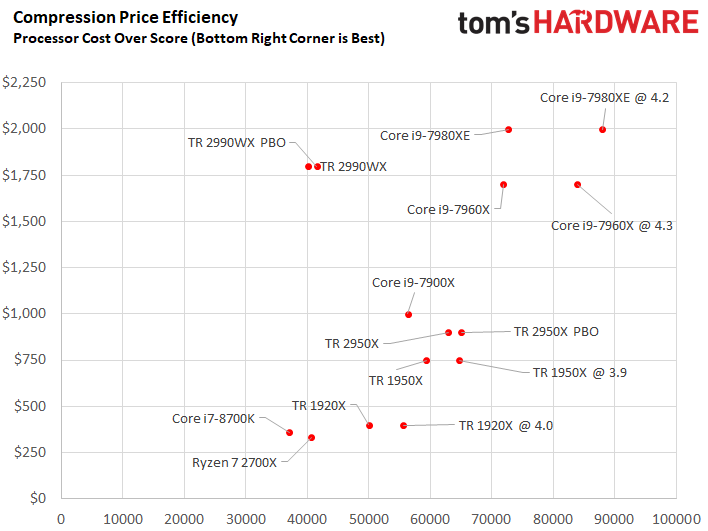
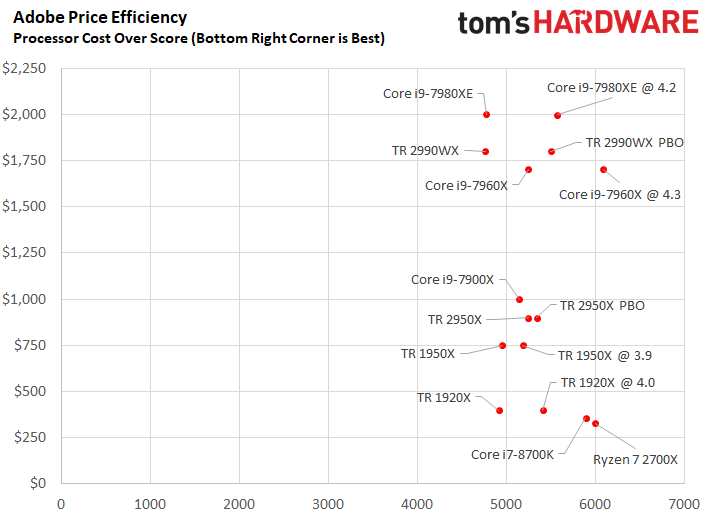


That means the Threadripper 2950X excels in decompression, compression, and rendering applications, but the chips also provide more than acceptable performance across our wide range of lightly-threaded workloads. The Threadripper 2990WX is a special case, though. This unique processor provides incredible performance in applications that scale well and aren't memory sensitive, but some workloads suffer due to the chips' architecture. AVX workloads generally do not scale well and some tests, like compression, are a notable weakness. The chip also generally struggles in lightly-threaded tasks, like browsers, but overclocking can help boost performance.
Intel's Skylake-X processors also provide solid performance in threaded applications, but they excel in lightly-threaded apps. That includes applications like the Adobe Creative Cloud Suite, web browsers, single-core rendering workloads, and our LAME encoding benchmark. Intel also enjoys a performance advantage in applications that leverage powerful AVX instructions, like our x265 HandBrake test.
Winner: Tie. If you are primarily browsing the web, using office apps or even playing with Adobe's creative suite, Intel is faster. However, if you use a lot of multi-threaded, non-Adobe software for rendering videos, photos and animations, AMD is a better choice.
Value
AMD's ultra-competitive pricing means the company offers more bang for your buck. Our chart above breaks down the price-per-core of the respective lineups, and AMD's prices dip as low as $33 per core for the first-gen Threadripper models. For Threadripper 2 , AMD drops as low as $56 a core. In comparison, Intel's lowest price-per-core weighs in at $65 for its six-core model, but the beefier 12-core models start at $100 per core.
AMD's new range-topping Threadripper 2990WX does carry a steep $1,799 price tag for 32-cores and 64-threads, but if heavily threaded applications are your thing, the chips offer a much better value than Intel's $1,999 asking price for the 18-core 36-thread Core i9-7980XE.
Overall, the Threadripper 2950X is the winner of the bunch. This powerful processor handles well in a diverse number of applications, and Intel's comparable Core i9-7960X weighs in at nearly twice the price.
Intel's processors are generally faster with many types of applications, but AMD wins on performance per dollar. Intel needs to update its pricing or release a new lineup, stat.
Winner: AMD Threadripper 2 by a landslide.
Bottom Line
Threadripper 2 pulls out a narrow win in our comparisons. Of the seven rounds in our face-off, two -- overclocking and productivity performance -- were a tie. AMD's return to prominence in the high end segment is a godsend to enthusiasts and professional users alike. As a consumer, you now have a wide variety of potent choices from two competitive manufacturers, and AMD is keeping Intel honest on pricing.
Which CPU platform you choose should depend on two main factors: your budget and what types of software you use most. If you want the best performance for the majority of games and productivity apps, which are lightly threaded, Intel Skylake-X is your top choice. However, if you want the best speed for the money or you use a lot of heavily-threaded apps, AMD Threadripper 2 has the upper hand
And, if you're simply after the best bang for your buck, Threadripper 2 is the clear winner.
| Round | Intel Skylake-X | AMD Ryzen Threadripper 2 |
| Features | Row 1 - Cell 1 | ✗ |
| Overclocking | ✗ | ✗` |
| Coolers | Row 3 - Cell 1 | ✗ |
| Motherboards | ✗ | Row 4 - Cell 2 |
| Gaming Performance | ✗ | Row 5 - Cell 2 |
| Productivity Performance | ✗ | ✗ |
| Value | Row 7 - Cell 1 | ✗ |
| Total | 4 | 5 |
MORE: Best CPUs
MORE: Intel & AMD Processor Hierarchy
MORE: All CPUs Content

Paul Alcorn is the Editor-in-Chief for Tom's Hardware US. He also writes news and reviews on CPUs, storage, and enterprise hardware.
-
shabbo One of the dumbest review I've read. Only thing Intel is good at is providing a few percent better gaming performance on a chip that's not even meant for gaming.Reply
1) Motherboard choices?? Who cares about that and why should it carry equal weight to other more important categories in this match up? There's more then enough motherboard choices for Threadripper and these motherboards are probably better built and will support future processors. Useless category and the winner should be AMD here
2) Gaming performance. Who the heck cares about the little advantage one may have over the other. Instead it should be game development performance. You just created this category to award Intel a point.
3) Productivity. How is this even a tie? I can run over half a dozen more VMs at higher performance on AMD. I can have more 10GE NICs and better I/O and be way more productive on AMD. -
bsaghafi The chart in the Features section states the AMD TR 1950x and 1920x as having 64 MB L3 cache while it should be 32 MB.Reply -
mbjgjol Benchmark:Reply
Use dBpoweramp to encode 250 mp3 files. Its support multi-CPU!
I will love to see the winner of this! ;-) -
justanothergeek "Intel holds the per-core performance advantage and generally processes more instructions per cycle (IPC)".Reply
Is this before or after all the spectre meltdown patches and security patches have been applied?
Honestly, I would like to see the comparison with after Intel and AMD security patches have been applied, which would be a real world scenario.
Is Tom'sHardware going to have benchmarks on the L1 cache security updates for possible performance degradations?
Source: https://www.altchar.com/hardware/575144/intel-makes-publishing-cpu-benchmarks-illegal-after-security-patch
-
yurius_r if you spent some time you can find support on x299 platform even RDIMM support. But ECC working question still remains - RDIMMS works fine, but who knows if ecc enabledReply
